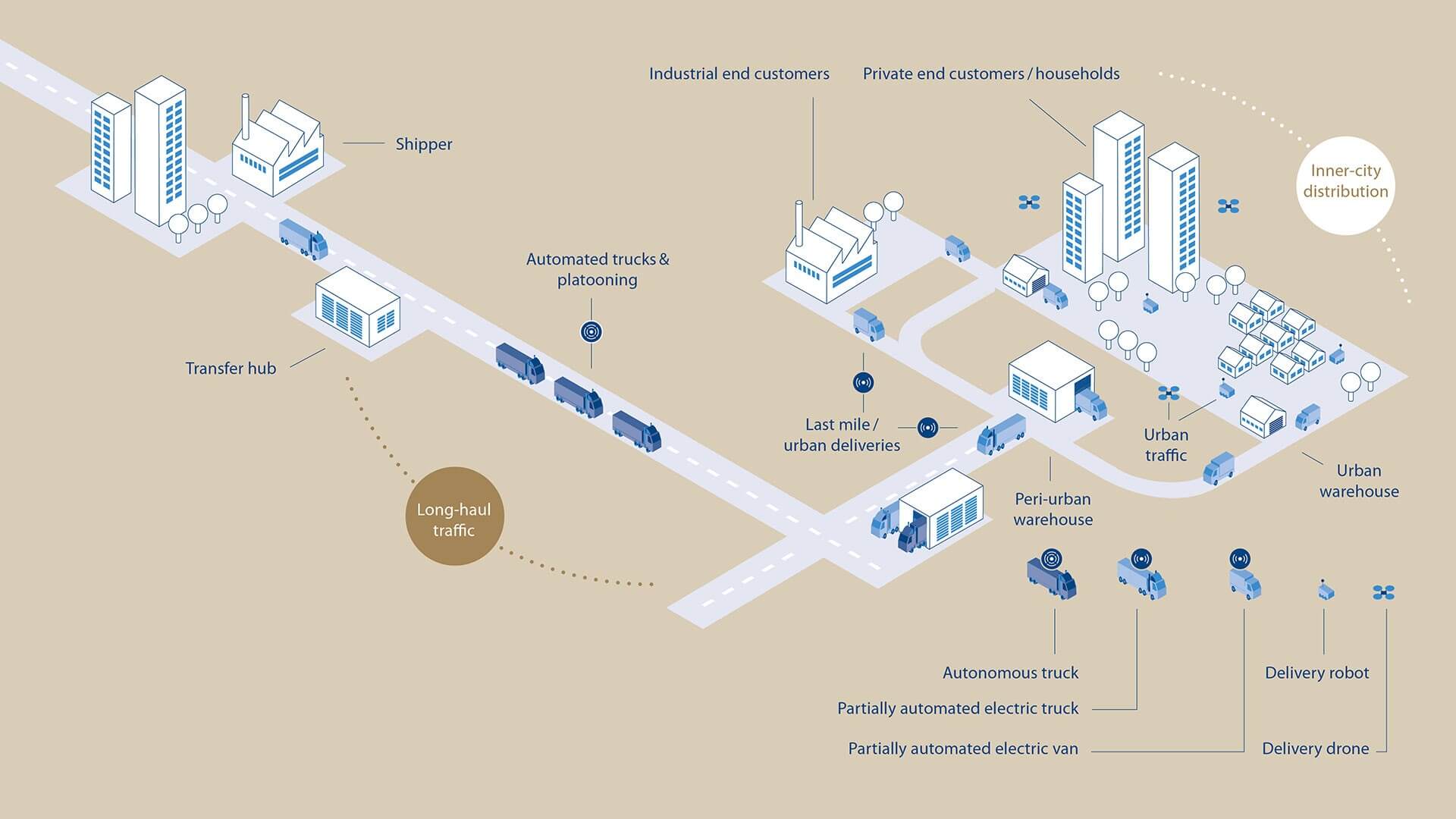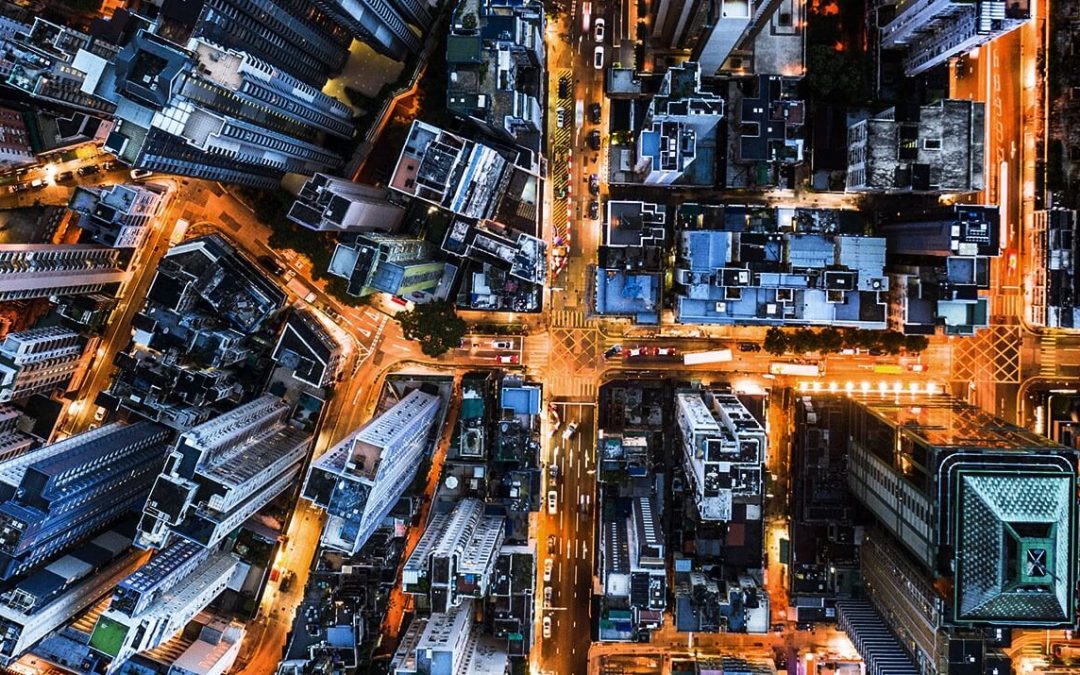Truck platoons on the highway, autonomous vans in the city, parcel deliveries by drone: this is the logistics of the future. Where do the disruptive challenges and opportunities lie for truck fleet operators, what trends are emerging and what innovations are being developed?
The trucking industry and logistics companies are facing major challenges: growing market fragmentation, inefficiency, poor utilization of trucks, a shortage of drivers and ever stricter emissions regulations are putting freight carriers under pressure around the world. Cost-efficient solutions are required, with business models that reflect global developments and trends such as automated driving, electromobility, digitalization and connectivity.
Efficient goods supply chain
How will goods reach processing companies, traders and consumers at low cost in the future? Highly automated delivery trucks will play a key role in this system. With its platooning and HAD solutions, Knorr-Bremse is at the heart of this dynamic field that will help shape the logistics of the future.
Self-driving trucks for long-haul transport
Over long distances, driverless trucks will play the main role. The self-driving trucks will reduce the number of accidents, which means lower downtimes and insurance premiums. Fuel savings and electric mobility will cut emissions, while digital booking systems will ensure fewer empty runs. More on platooning .
Transfer hubs along highways, drones in the city
Long-haul and urban transport will be connected up by transfer hubs with easy highway access. Here the trailers will be switched from the long-haul trucks to the vehicles heading for the peri-urban and urban warehouses. Smaller vans, drones and delivery robots will then take care of the last mile, i.e. inner-city distribution from networked warehouses to customers. These vehicles are best placed to meet ever-increasing customer expectations in terms of delivery times, transparency and flexibility.

Technical transformation of logistics through digitalization
Digitalization is bringing disruptive technological change to the logistics industry. All companies and employees involved in the logistics chain are being assigned new tasks: networking, reporting, analyzing and transferring data and information. New business models are being offered that include mobility services, shedding new light on the question: How do I achieve the lowest costs?
The demands placed on logistics companies are changing
For instance, having an ergonomic and comfortable driver’s cab will become less important, while boosting transport capacities at the lowest possible energy costs is really coming to the fore. Yet even the best technology is only effective if the information system is coherent, transparent and absolutely reliable. This is especially true for truck fleets. Frank Pietras, Partner at the consultancy Roland Berger in Munich, knows how to align them to future needs. The automotive expert advises with in-depth specialist knowledge in the areas of commercial vehicles, commercial due diligences, global growth strategy and market and product strategy.
Target state of the logistics landscape
Interview with Frank Pietras, Partner at Roland Berger in Munich, on the necessary realignment of truck fleets for logistics companies
You call the logistics of the future an “endgame scenario”. Is it as dramatic as it sounds?
Not at all. Our “endgame scenario” describes a target state of the logistics landscape. This target state will represent a significant improvement on the initial situation today. In this future logistics ecosystem, “frictional losses” will be minimized. These are losses due to inefficient processes, suboptimal utilization such as empty runs, and also safety risks.
When will the logistics of the future become reality?
It is true that the path to the logistics ecosystem described above brings a number of uncertainties for market participants. For example, it is currently not possible to foresee with complete accuracy how long it will take to realize the scenario. This stems from various factors such as technological developments and the timing of new legislation required for highly automated driving. Infrastructure investments are also needed, for example in transfer hubs along highways.
Will fleet operators need to acquire just as much expertise in big data as they have in trucking?
Fleet operators must ensure that they make full use of the opportunities presented by new technologies and digitalization for their particular purpose. This will give them an edge in terms of reduced logistics costs or greater efficiency.
So fleet operators must begin by investing in future-proof logistics.
Yes, investments in new systems and process optimization are essential. It is then up to the fleet operators whether to use the available systems by developing their own competence, through service providers or through partnerships.
And then it’s time to choose a business model?
That’s right. The fleet operator must decide on a future business model. Should the focus remain on fleet operation or the provision of transport solutions? Using the company’s own trucks or by subcontracting? Or does the fleet operator of today want to play another role in the logistics of the future?
What kinds of business models are you thinking of?
The fleet operator has to find answers: Which technologies should I invest in and how can I secure financing? After all, the fully automated and digitalized logistics ecosystem offers many new sources of income for large fleet operators. These need to be differentiated and developed. Options might include partnerships in the operation of booking platforms for freight enquiries, or automated transfer hubs as an interface between long-haul transport and urban logistics centers.



